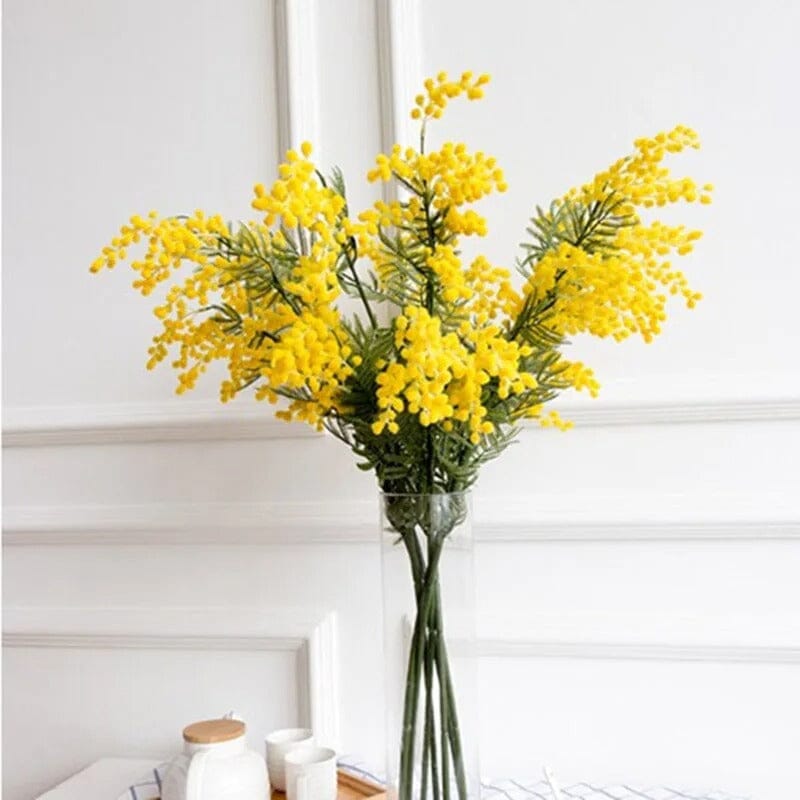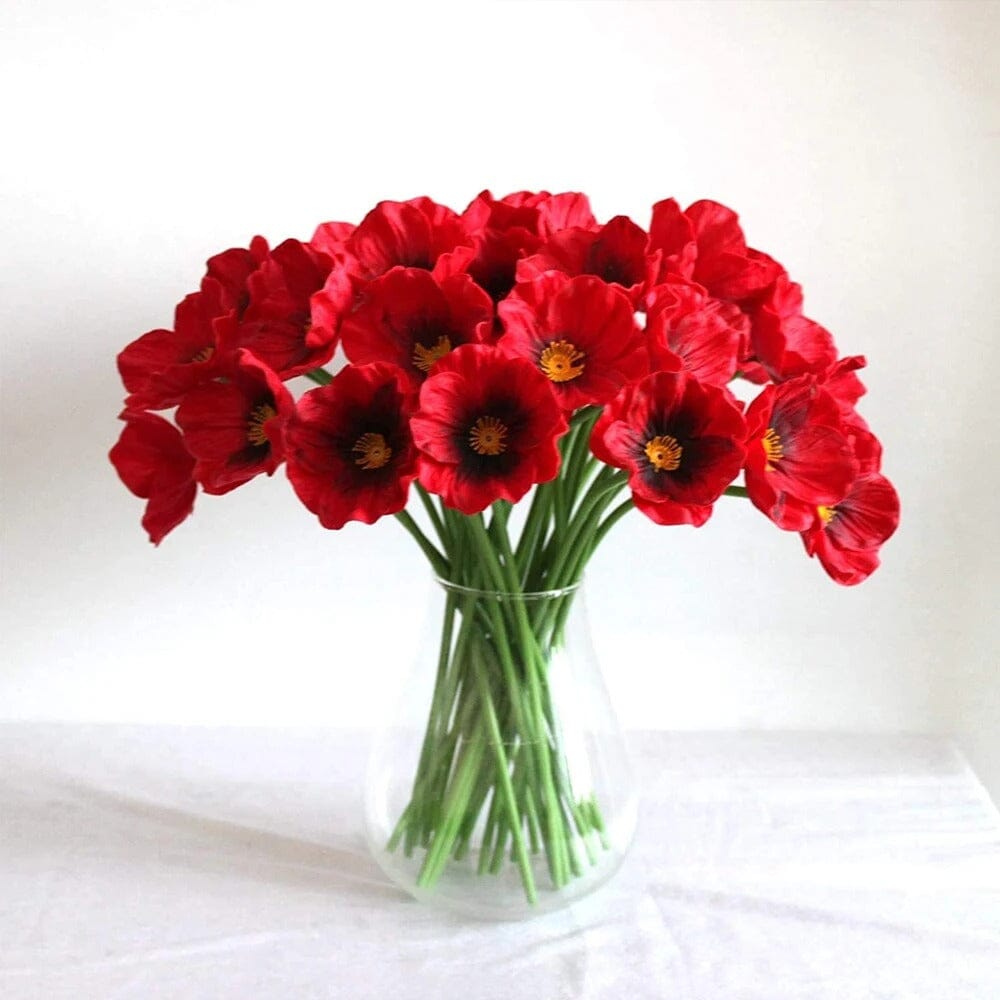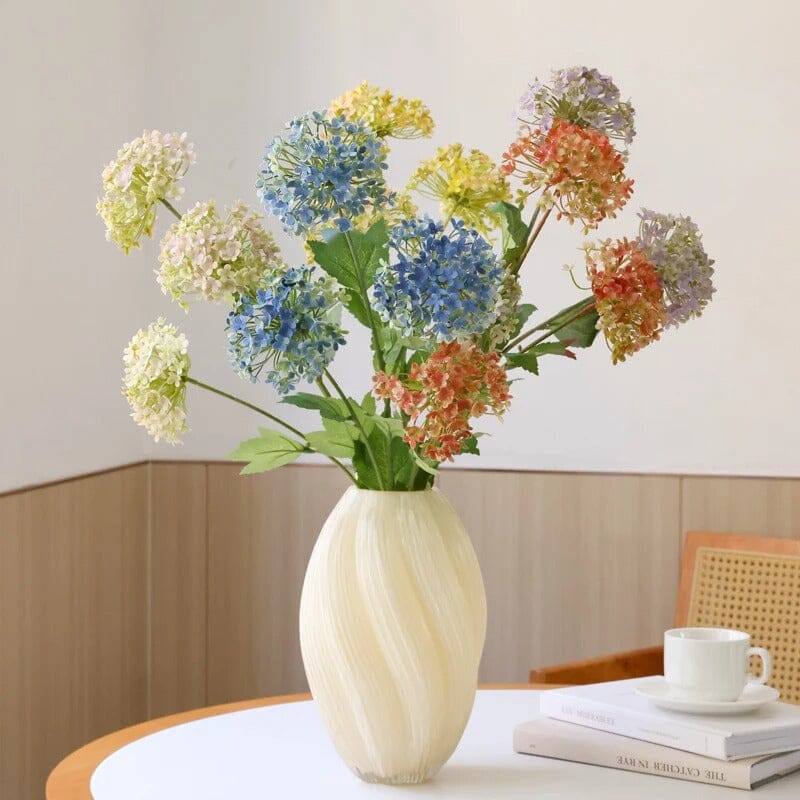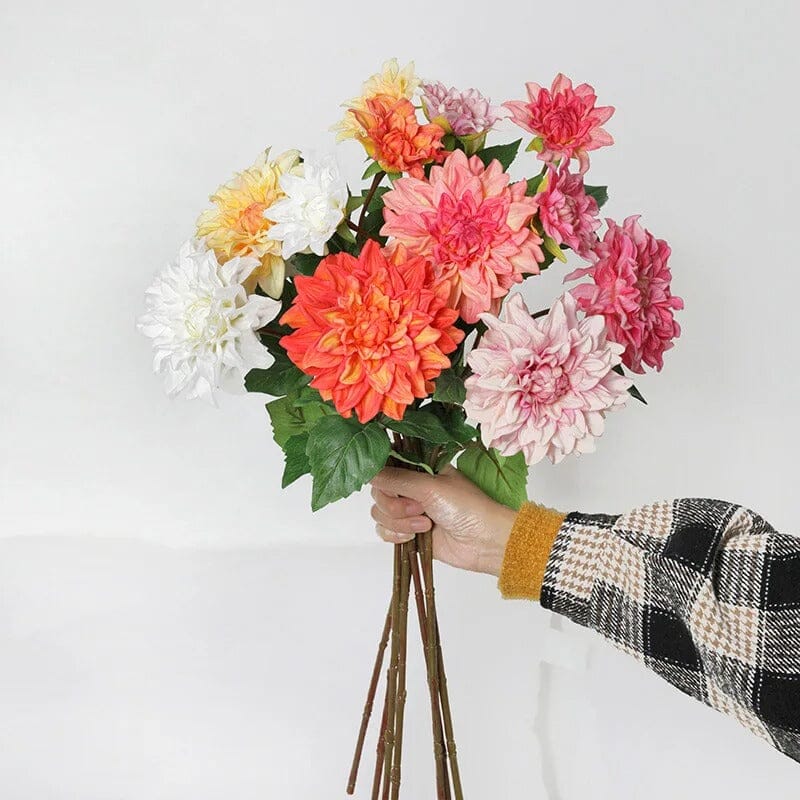🌸 Forgotten flowers that deserve a comeback
Long the stars of gardens, our grandmothers' bouquets, or the colorful balconies of yesteryear, some flowers have gradually fallen into oblivion, dethroned by "minimalist" trends, exotic plants, or trendy foliage. Yet, these varieties have everything going for them: a strong history, authentic beauty, and an old-fashioned charm that's back in fashion more than ever.
Carnation, gladiolus, mimosa, geranium, hydrangea, iris… These flowers deserve more than a nostalgic glance. What if it's time to give them back the place they deserve in our homes and our hearts ?

🌺 1. The carnation: the “old-fashioned” flower that has become retro-chic
Once a symbol of floral elegance, the carnation has long been forgotten. Overly common in formal ceremonies, associated with stiff buttonholes or somewhat dated bouquets, it has lost its appeal... until now.
💬 Its history & its symbolism:
Cultivated since antiquity, the carnation (from the Latin Dianthus , "flower of the gods") has been a symbol of love, fidelity, revolution, and... elegance. In the 19th century, it adorned bodices, centerpieces, and even hairstyles. It evoked deep love, dignity, and restrained tenderness.
🖼️ Why it's back today:
- ✅ Its crumpled petals give a “couture” effect that is highly sought after in modern bouquets
- ✅ It comes in ultra trendy colors (terracotta, old pink, cream, burgundy)
- ✅ It lasts a long time in a vase, with a romantic elegance... but without pretension
🌿 How to adopt it in decoration?
The eyelet fits perfectly into:
- – A bohemian bouquet mixed with pampas grass or statice
- – A vintage cut in the style of a “slow deco” centerpiece
- – An artificial rosebud in a single-flower vase for a retro touch without the maintenance
💡 The right mix?
Combine high-quality fabric carnations with a few fresh flowers: stunningly realistic and more durable for your home decor.
🌼 2. Mimosa: the sunny flower, sweet and full of history
As soon as winter sets in, the mimosa appears like a ray of sunshine falling from the sky. And yet, this luminous flower is often confined to a somewhat outdated image , associated with grandmother's bouquets or southern parades... wrongly!
📜 A little history:
Native to Australia, mimosa was introduced to Europe in the 19th century. It quickly established itself on the French Riviera, where it became a symbol of renewal, warmth, and festivity. Its powdery fragrance, small fluffy balls, and vibrant color have made it the ultimate anti-depression flower.
🌼 Why it's back today:
- ✅ Its bright yellow color is perfect for warming up a neutral decor
- ✅ He is ultra photogenic (hello Instagram!) with his fluffy pompoms
- ✅ In dried or artificial version, it lasts a long time and keeps its charm
🖼️ How to integrate it into your decor?
Mimosa works wonders:
- – In small touches in a single-flower vase for a luminous ambiance
- – In a dried bouquet “back from the market” style in a kitchen or entrance hall
- – In artificial stem in a wall wreath or on a shelf
💡 Decorating tip:
Combine mimosa with natural materials (linen, raw wood, pottery) to enhance its soft, sunny side. And for a lasting effect without loss of pollen: try artificial mimosa , ultra-realistic and stress-free.
☀️ Mimosa, a touch of sunshine… without maintenance
A vibrant, luminous flower with no strings attached? Treat yourself to the beauty of the everlasting mimosa to warm your home all year round.

🌼 See the high-end artificial mimosa
🌸 3. Gladiolus: the vertical majesty unjustly forgotten
The gladiolus, with its long, powerful stems and spectacular blooms, has long been synonymous with grandeur, triumph... and slightly '80s-style arrangements. The result? It has disappeared from our living rooms, unfairly relegated to ceremonial arrangements. Yet, **it's back, and it's back strong.**
⚔️ A warrior name, a strong symbolism:
The word "gladiolus" comes from the Latin gladius (sword). In ancient times, it symbolized victory. Giving a gladiolus was a way of paying tribute to courage, inner strength, or admiration for a proud and upright person.
🌈 Why it's back today:
- ✅ Its vertical silhouette enhances modern and minimalist compositions
- ✅ It comes in an incredible variety of colors: pastel, pure white, flamboyant red, soft salmon…
- ✅ It creates a powerful structure in a bouquet, perfect for large vases and sculptural decorations
🏺 How to reintegrate it into your decor?
Gladiolus is ideally used:
- – In a tall vase, alone or in groups of three, for a dramatic and elegant entrance
- – In a modern bouquet, with exotic foliage or grasses for contrast
- – In artificial version in a poorly lit corner: structure + color, without constraint
💡 The right decor combo:
Gladioli + succulents (grasses) = a structured and graphic bouquet, perfect for a contemporary living room. And high-end artificial flowers? It's stunning.
👑 4. The iris: between royal flower and artistic muse
The iris is one of the most majestic flowers, at once complex, poetic, and graphic. Yet, in our modern interiors, it is curiously under-represented. This is a shame, because it has everything going for it: a mythological history, a sophisticated shape, and a natural elegance that never goes out of style.
📖 A little mythology and royalty:
In Greek mythology, Iris is the messenger of the gods and personifies the rainbow. The iris was later adopted as a royal symbol in France, along with the famous fleur-de-lis (actually inspired by the yellow flag iris). It is a flower of power, elegance, and spirituality.
🎨 A muse for artists:
Van Gogh, Monet, Klimt… They all painted the iris. And for good reason: its complex shapes, intense color gradients, and slender silhouette make it a visually fascinating flower.
🌈 Why the iris deserves a decorative comeback:
- ✅ It comes in deep blue, royal purple, pristine white or luminous yellow
- ✅ Its sculpted shape brings verticality and refinement
- ✅ It evokes art, history and nature in a single glance
🏡 How to adopt it in your interior?
The iris is ideal:
- – In a tall single-flower vase for a minimalist display
- – In a romantic bouquet with peonies, old roses and fine foliage
- – In a high-end artificial version to maintain its elegance throughout the year
💡 The little decorative twist:
An iris placed in a matte ceramic vase, placed on an arty console or shelf, gives a “Parisian gallery” look to any room.
🌺 5. The poppy: the dreamlike and fragile flower that fascinates
The poppy is one of those flowers that seems to have come straight out of a dream. Ephemeral, delicate, almost unreal, it floats between romanticism and melancholy... and yet, **it's making a strong comeback in floral trends**, particularly in rustic or bohemian bouquets.
🌙 A strong and ambivalent symbolism:
The poppy is a symbol of sleep, dreams, forgetting, and in some cultures, also of resurrection. Used since ancient times for its soothing properties, it has inspired artists and poets. In the language of flowers, it can mean "I think of you," "I remember," or "Let me dream."
🧡 Why it's attractive again today:
- ✅ It brings an incomparable visual lightness
- ✅ Its natural movement adds poetry to a bouquet
- ✅ It evokes nature, fields, sweet memories
- ✅ It is sublime in dried or artificial version, well worked
🎨 How to incorporate poppies into your decor?
The poppy finds its place:
- – In a minimalist bouquet with a few thin stems and grasses
- – In bohemian compositions with lavender, wheat, statice and dried flowers
- – In delicate artificial stems in a glass bell jar or bottle vase
💡 Did you know?
Poppies are very difficult to keep fresh in a vase. But in a high-end artificial version, they keep their poetic shape... forever 🌸
🌺 The eternal poppy, for a poetic and fade-free decoration
Fragile in real life, but magical in decoration: this bright red artificial poppy enhances your interiors with softness and naturalness, for a long time.

🌺 See the 46 cm artificial poppy
🌾 6. The poppy: the red emotion of the fields of yesteryear
If there's one flower that immediately evokes childhood memories, summer walks, and poetry, it's the poppy. Wild, fragile, ephemeral... it grows wherever it wants, whenever it wants, without asking for help—and that's what makes it so endearing.
❤️ A strong and universal symbolism:
In many cultures, the poppy is a symbol of remembrance, peace, and repose. It has become an emblem of remembrance for fallen soldiers, particularly in Europe. But it is also a flower that expresses lightness, freedom, and fleeting beauty.
🌺 Why it’s coming back in force:
- ✅ It embodies the natural, the rustic, the real
- ✅ Its intense red color attracts the eye without overdoing it
- ✅ It is ideal for nostalgic, bohemian or rural decors
- ✅ It is sublime in dried or artificial version (the real ones fade too quickly!)
🏡 How to invite the poppy into your home?
This flower works very well:
- – In a bouquet of dried flowers with wheat, lavender and immortelles
- – A touch of color in a minimalist vase on a raw wood table
- – In artificial flower to keep this wild beauty intact all year round
💡 Soft decor tip:
Pair a few poppies with a vintage carafe, a white tablecloth, and antique crockery for an irresistible "country house chic" feel.
❤️ The eternal poppy: wild, tender and timeless
This bouquet of artificial poppies captures all the poetry of the fields, without fading. A bright and natural touch of red, perfect in a vase or as wall decoration.

❤️ See the bouquet of poppies
🌞 7. Nasturtium: an edible flower full of good humor
With its vibrant colors, round leaves like small water lilies, and slightly casual appearance, nasturtium is a flower that exudes joy. Yet, despite its aesthetic and flavor qualities, it has long been neglected in modern decor. Today, it's making a comeback... and it's no coincidence.
🍽️ A flower you can eat? Oh yes!
Few people know this, but nasturtium is **entirely edible**: its flowers have a very delicate peppery flavor (between radish and watercress), ideal in salads. Even its leaves and seeds are edible! It is therefore a flower that is both decorative... and culinary.
🌈 Why it’s becoming trendy again:
- ✅ It grows easily, even in a planter or balcony
- ✅ Its orange, red or yellow tones bring life to an interior
- ✅ It embodies naturalness, vintage, the old-fashioned garden... in keeping with the times
- ✅ It inspires designers (fashion, tableware, textiles) with its graphic shapes
🪴 How to integrate it into your decor?
Nasturtium can be grown:
- – In a planter or hanging on a balcony, in the countryside or in the city
- – In a country bouquet (fresh or artificial ) in a kitchen
- – As a natural and edible table decoration for summer meals
💡 The vintage wink:
Combine a few nasturtiums with an old tin can or a bottle repurposed into a vase for a retro-garden ambiance that's completely in tune with the times.
💐 8. Hydrangea: volume, softness and romantic charm
It's impossible to miss the hydrangea in your grandmother's garden. Its large, round flower heads, full of nuances and poetry, make it a **flower as impressive as it is delicate**. Once forgotten, it's now making a comeback in chic bouquets, weddings, and high-end decor.
📖 History and symbolism:
Native to Asia, the hydrangea was introduced to Europe in the 18th century. Its ability to change color depending on the acidity of the soil gives it an almost magical quality. It symbolizes **gratitude, inner peace**, but also… **a slightly capricious love** (hello color changes!).
🎨 Why it’s attractive again:
- ✅ It brings volume and romanticism to any composition
- ✅ It comes in pale pink, sky blue, cream white, mint green…
- ✅ It keeps very well as a dried or artificial flower
- ✅ It evokes the chic countryside, old houses, refined living rooms
🏡 How to integrate hydrangeas into your decor?
The hydrangea is perfect:
- – In a single bouquet in a stoneware or blown glass vase
- – In wall crown, dried or in artificial version
- – As a romantic centerpiece with some textured foliage
💡 Soft and elegant decor:
A single artificial hydrangea stem in a simple vase can be enough to dress up a console table, bedroom, or entryway. It creates an immediate "flower castle" effect without fading.
💐 The eternal hydrangea: romanticism, volume and softness
As majestic as it is timeless, this 74 cm artificial hydrangea brings a touch of refined charm to your vases, without wilting or losing its petals.

💐 See the 74 cm artificial hydrangea
🎇 9. The dahlia: floral explosion and graphic elegance
If there's one flower that's a real eye-catcher without ever being vulgar, it's the dahlia. Sometimes shunned for its somewhat "overly sophisticated" look, it's now back in the spotlight, a favorite of florists and a star of weddings.
📖 Origins & floral personality:
Native to Mexico, the dahlia has been crowned the country's national flower. It is a symbol of creativity, generosity, and refinement. With over 20,000 varieties, it can be round, star-shaped, pompom-shaped, serrated, solid, or multicolored. In short, a floral superstar.
🌈 Why we love it again:
- ✅ Its vibrant colors and original shapes
- ✅ It creates an immediate "wow" effect, even alone
- ✅ It structures bouquets with class
- ✅ In the artificial version, it retains all its panache without fading
🏺 How to enhance it in decoration?
The dahlia is perfect for:
- – A chic monochrome bouquet (e.g. plum or cream tones)
- – Bold compositions for a dining room or an event
- – A sculptural vase + a single artificial stem for a minimalist but impactful decoration
💡 Contemporary inspiration:
Pair a dahlia with matte foliage (eucalyptus, ruscus) to create a modern contrast. And in the artificial version , it is absolutely stunning.
🤍 The eternal white dahlia: purity and sculpted elegance
With its structured petals and silky shine, this white artificial dahlia gracefully enhances your floral arrangements without ever fading.

🤍 See the 60 cm white artificial dahlia
🌼 10. Marigold (calendula): flower of the sun and ancient remedies
Relegated to cottage gardens or vegetable patches for too long, marigolds deserve to find their place in our homes. This simple, bright, and medicinal flower has a lot to offer: a vibrant yellow, a cheerful shape, and a natural aura full of kindness.
🧴 A treasure of nature:
Calendula has been used for centuries for its soothing, healing, and anti-inflammatory properties. It's found in many creams, infusions, and natural treatments. But beyond being a remedy, it's also a true decorative flower.
☀️ Why it’s slowly coming back into fashion:
- ✅ It brings a sunny touch to a natural or rustic decor
- ✅ Its "apothecary plant" side appeals to slow living enthusiasts
- ✅ It fits well in dried flower bouquets
- ✅ It is beautiful in artificial version , keeping its shine without fading
🏺 How to integrate marigold into decoration?
The concern works wonderfully:
- – In a small rustic bouquet on a light wooden table
- – As a contrasting element in a wall floral wreath
- – In a colorful soliflore for a vintage nod in a kitchen
💡 The “nature & well-being” decor tip:
Pair a few marigold stems with terracotta pots, a wicker basket, or an antique kitchen scale for a "grandma's house chic" feel.
🌸 11. Freesia: a delicate flower with an unforgettable fragrance
Freesia is one of those flowers you can recognize with your eyes closed. Subtly fragrant, airy, and graceful, it has long been associated with bridal bouquets, grand floral salons, and delicate gestures. Today, we're rediscovering it for what it is: a poetic and sophisticated flower, ideal for delicate and elegant interiors.
🌬️ A fragrance in itself:
Freesia exudes a sweet, slightly citrusy fragrance that evokes the freshness of clean linen, summer mornings, or floral powder. It is often used in perfumes, cosmetics, and room mists.
🌈 Why it comes back in modern compositions:
- ✅ It symbolizes sincere friendship, elegance and loyalty
- ✅ Its fine, arched shape makes it very aesthetic in a light bouquet
- ✅ It comes in white, yellow, pink, purple, lavender… and two-tone
- ✅ It looks great in a high-end artificial version , especially for places without fragrance
🏠 How to invite it into the decor?
Freesia is ideal:
- – In a small minimalist bouquet in a matte white or transparent vase
- – To enhance an elegant bathroom, a dressing table or a bedside table
- – In an artificial stem in a single-flower vase, for a “constant freshness” effect all year round
💡 Soft and fragrant atmosphere:
Combine artificial white freesias with fragrance sticks for a chic yet understated scent.
🌼 The eternal yellow freesia: finesse, fragrance... and zero maintenance
Delicate, luminous and poetic, this yellow artificial freesia brings a touch of freshness and elegance to your interiors, without fading.

🌼 See the 51 cm artificial freesia
💞 12. The buttercup: roundness, romanticism and subtle elegance
With its multiple petals delicately stacked like ruffles, the ranunculus looks like it's straight out of a romantic tale. Less well-known than the peony or the rose, it nevertheless melts the hearts of lovers of chic floral decor. Refined, soft, ultra-photogenic ... we wonder why it disappeared from our homes.
📜 A delicate flower with an ancient history:
Known since ancient times, its name comes from the Latin “ranunculus” (little frog), as it often grows near water. It has long been a symbol of **modest seduction, discreet charm, and inner beauty**.
💗 Why it’s coming back in force:
- ✅ It offers a very “Instagrammable” aesthetic
- ✅ It comes in a wide pastel palette (white, peach, old pink, lilac)
- ✅ It brings softness and sophistication to any room
- ✅ In artificial version, it keeps its unique volume without being damaged
🪞 How to invite it into your decor?
The buttercup is perfect:
- – In floral arrangement for a bedroom, a bathroom or a festive table
- – In a pastel bouquet in a matte or transparent ceramic vase
- – In a single-flower vase or in a glass case, in a high-end artificial version
💡 Romantic inspiration:
Combine ranunculus with small English roses, eucalyptus and a few stems of baby's breath for a soft and feminine ambiance, natural yet sophisticated.
🌿 13. Amaranth: the drooping beauty with ancient charm
Amaranth, with its long, drooping clusters of purple-red or pale green, is a flower as mysterious as it is imposing. Little known to the general public, it is nevertheless prized by decorators for its **sculptural effect**, its **antique look**, and its incredible **vertical presence**.
🏺 A flower out of time:
The name “amaranth” comes from the Greek amarantos , meaning “never-fading.” In mythology, it was considered an eternal plant, a symbol of immortality, loyalty, and power. Its flowing, velvety shape evokes ancient draperies, royal finery, and symbolist paintings.
🎯 Why it’s making a comeback in modern decor:
- ✅ It brings a unique and dramatic touch to compositions
- ✅ It fits perfectly into bohemian or baroque decors
- ✅ It comes in deep colors (burgundy, fuchsia, wine red), perfect for fall or cozy atmospheres
- ✅ It is sublime in artificial version for an impeccable and lasting fallout
🏡 How to use it in decoration?
Amaranth is perfect for:
- – Adorn a fireplace, shelf or floral arch
- – Create original centerpieces by letting it fall to the sides
- – Add relief to a vertical composition (wedding, living room, window display)
💡 The detail that changes everything:
Amaranth works wonderfully in a duo with lighter flowers (fat, fine foliage, old roses) to play on contrasts of texture and volume.
💙 14. Cornflower: a wildflower full of emotion
Discreet, light, wild, and yet steeped in history, the cornflower is the quintessential wildflower. With its starry sky-blue or royal-blue petals, it evokes childhood, the countryside, and tender memories. And yet, this fragile little flower has a **deep symbolism of resilience and hope**.
📖 A memory flower:
The cornflower is the French symbol of memory and solidarity with veterans. It grows spontaneously in wheat fields and has survived all wars—a true symbol of perseverance and peace .
🌾 Why it's making a comeback:
- ✅ It evokes naturalness, the countryside and authenticity
- ✅ Its color is unique and soothing, ideal for soft decor
- ✅ It comes back in dried bouquets, rustic weddings, bohemian compositions
- ✅ It is magnificent in artificial or stabilized version for a long-lasting effect
🏡 How to use cornflowers in decoration?
Blueberry is perfect for:
- – Add a touch of blue to a country bouquet (with daisies and poppies)
- – Create a wall-mounted floral crown or a plant garland
- – Bring a fresh and bright accent to a rustic or romantic decor
💡 Country inspiration:
Combine cornflower with natural elements: linen, light wood, raw pottery... For a "summer in the countryside" atmosphere all year round, opt for a high-quality artificial version.
🌸 Giving life back to forgotten flowers means making our emotions bloom (again)
The charm of a delicate carnation, the poetry of a cornflower, the grandeur of a gladiolus or the sweetness of a ranunculus… These flowers are not simply memories of times gone by: they are vectors of soul, style and meaning. What if true luxury, today, was to reintroduce these forgotten beauties into our modern interiors?
In fresh, dried, or artificial bouquets, each of these flowers can tell a story in your home. It's up to you to choose the one(s) that will make your decor vibrate... and your heart 🌿
🌼 Discover our selection of forgotten flowers











Leave a comment